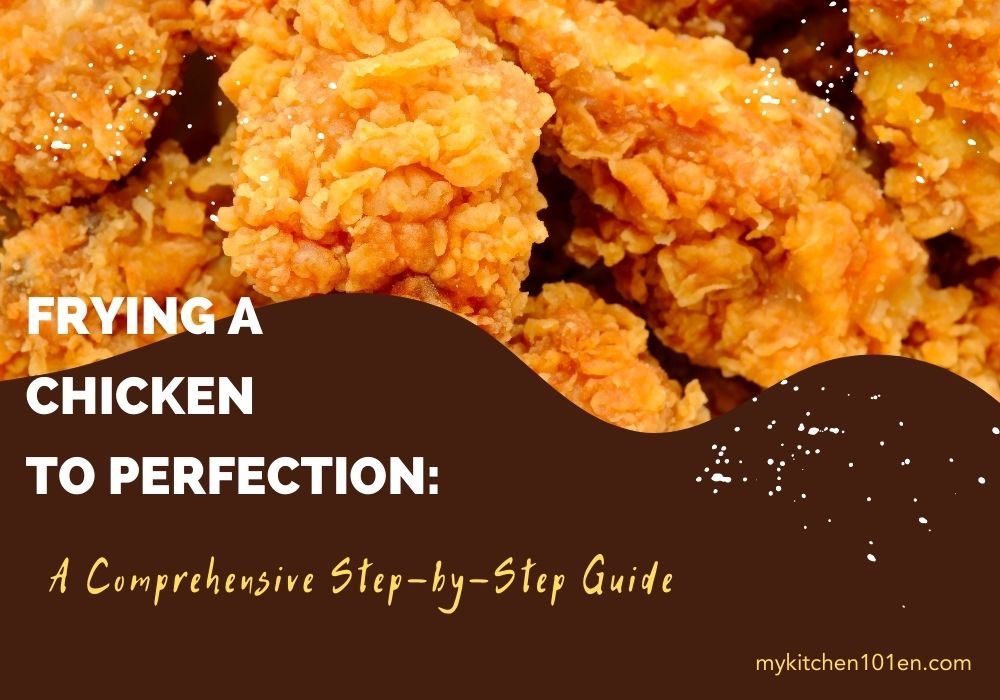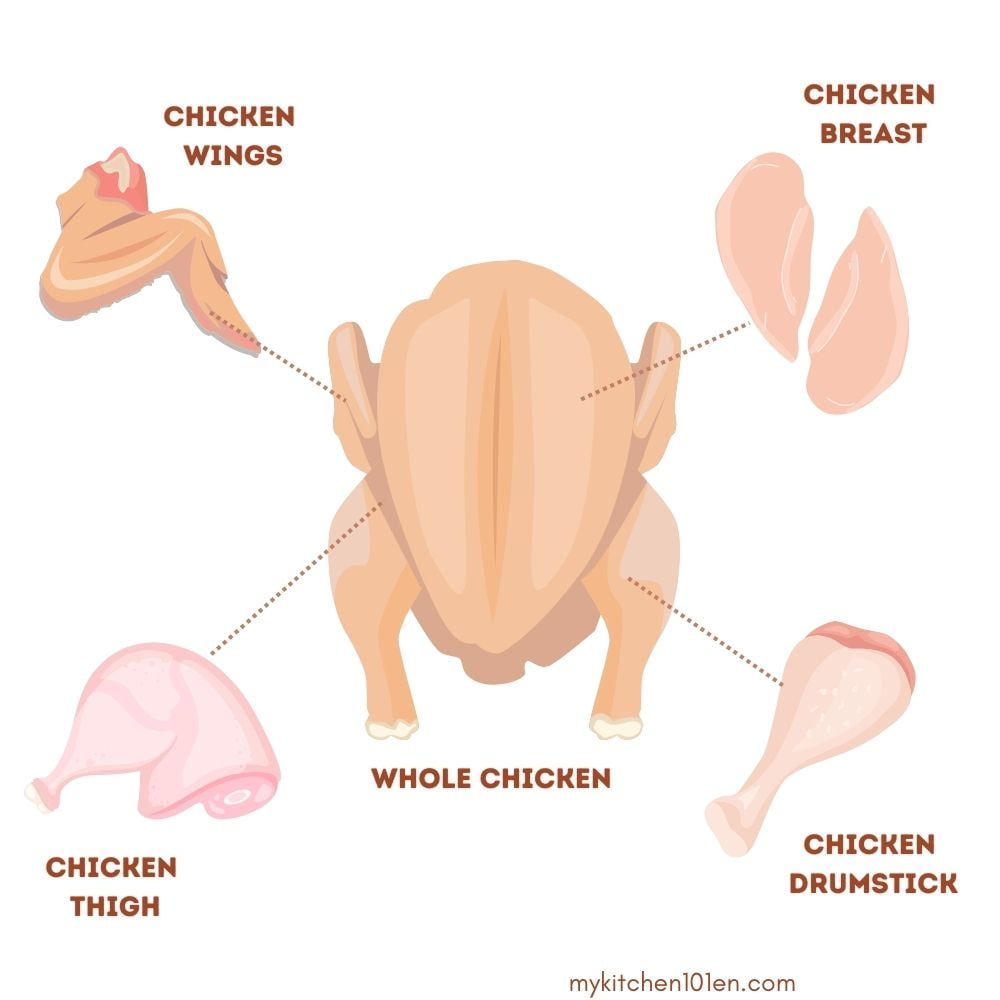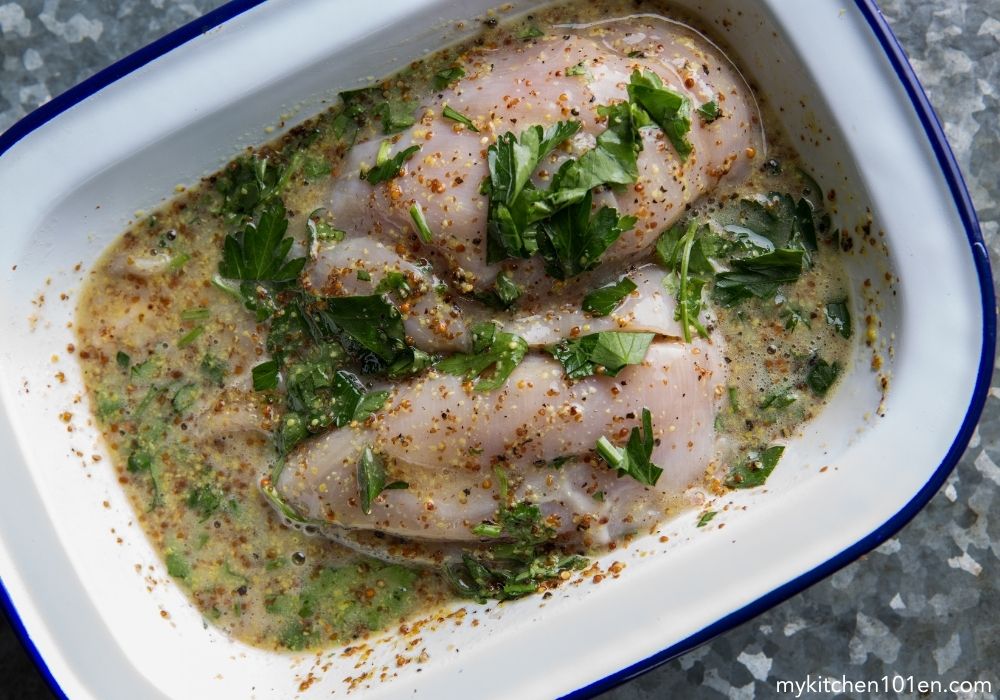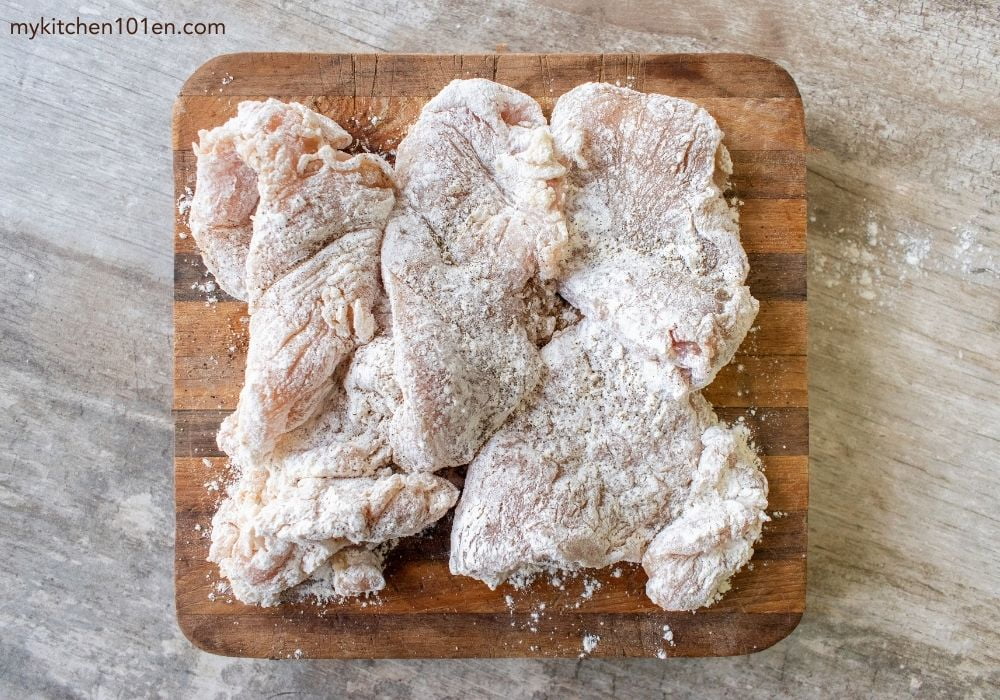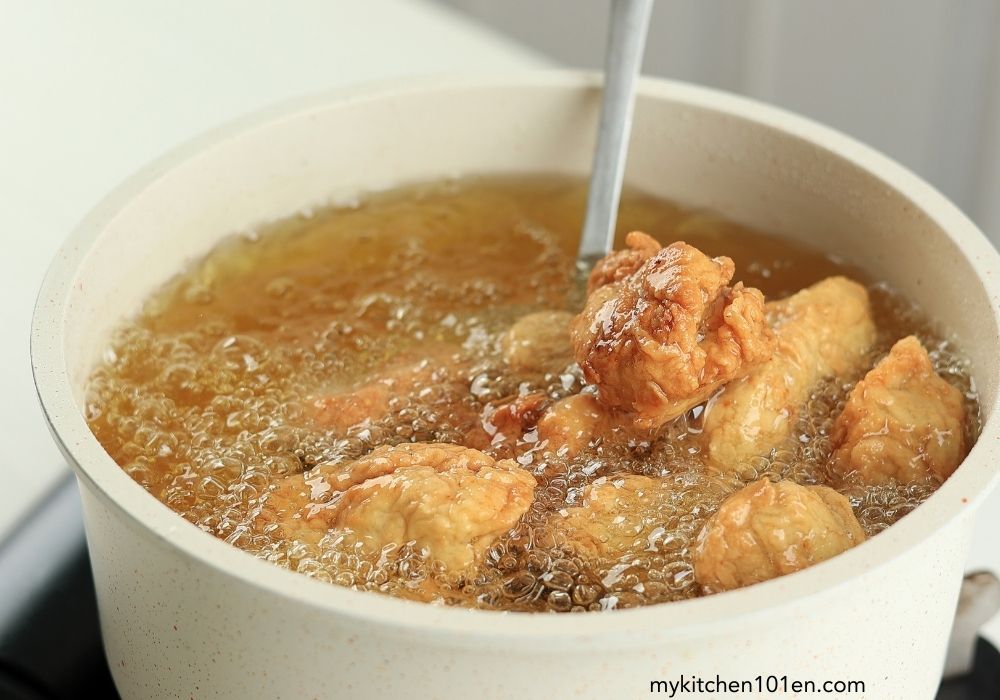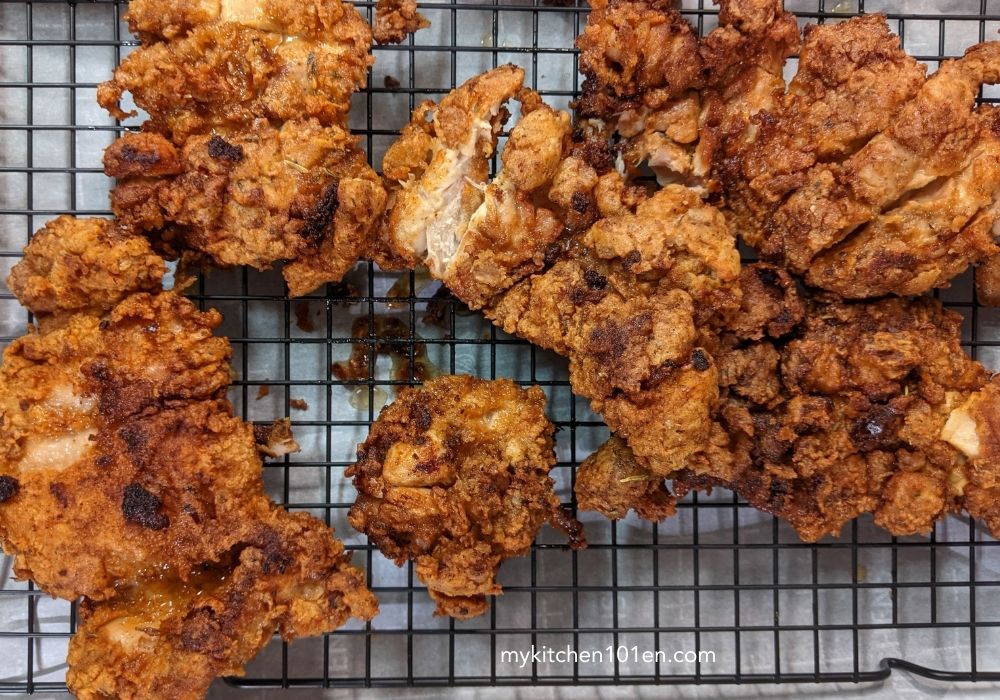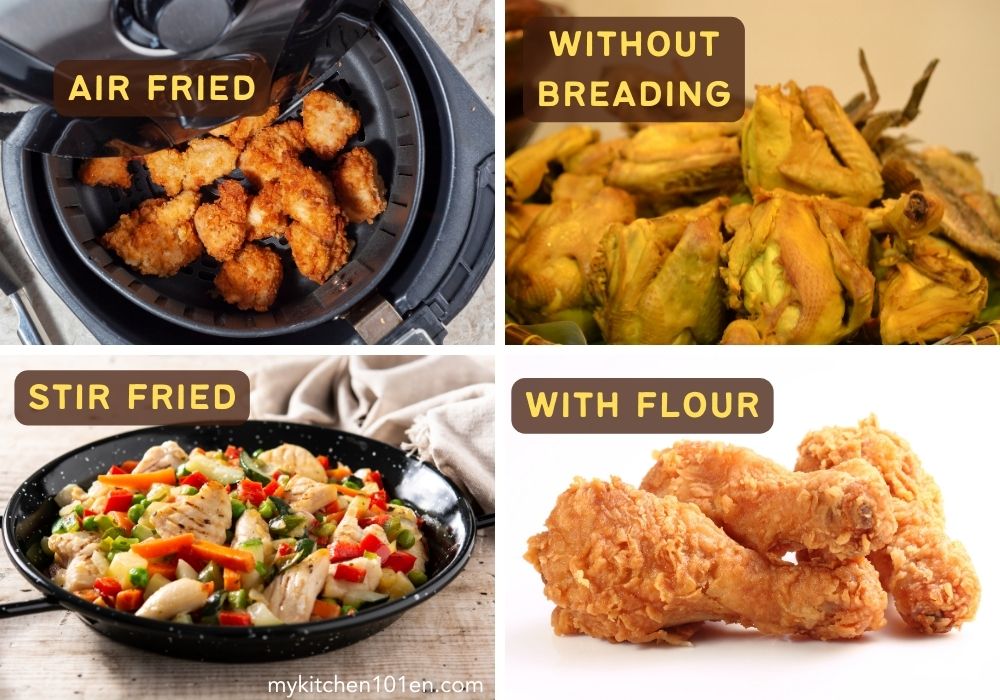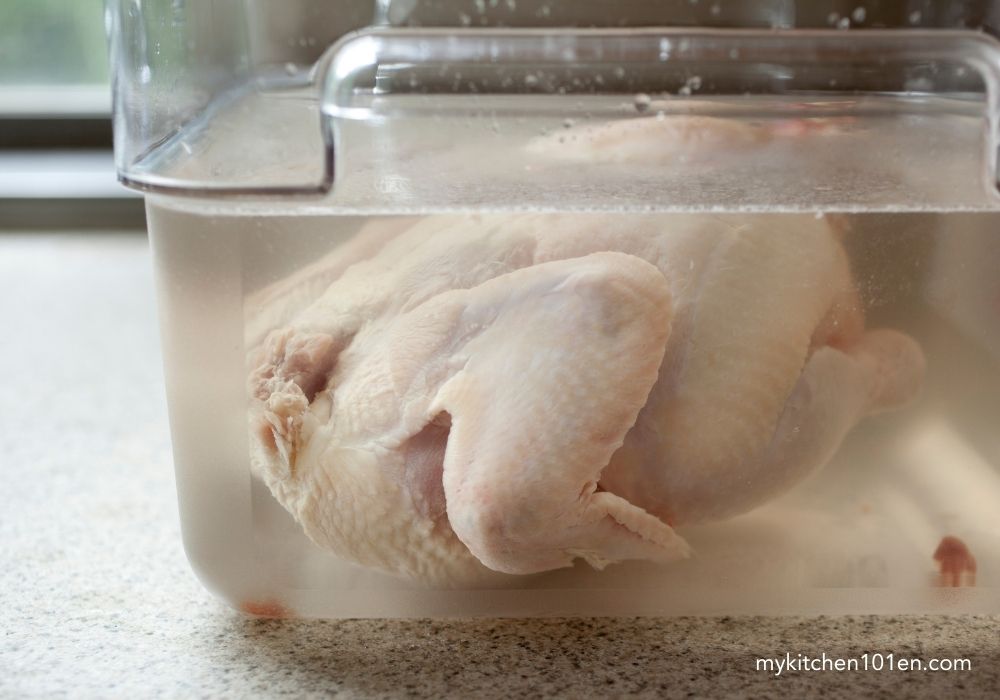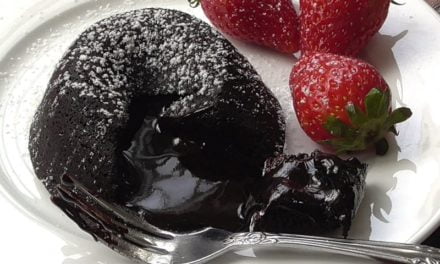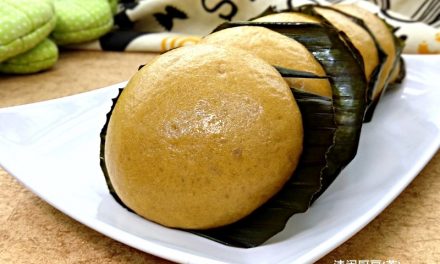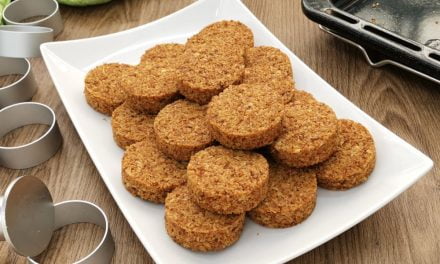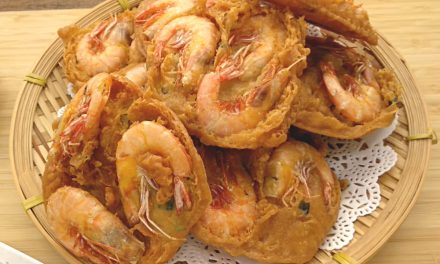Frying a chicken: have you ever wondered how to make it just right at home? Yes, that golden, crispy, mouth-watering delight that has us all smitten.
This universally loved dish has so many variations across the globe, but today, we’ll focus on the classic Southern-style American version.
From the crackling sound it makes while frying to the tantalizing aroma that fills the kitchen, everything about fried chicken is pure joy. But, the real magic lies in frying it correctly. It’s not just about dunking chicken into hot oil; it’s about the right ingredients, the perfect temperature, and, of course, love!
We will show you the secrets behind creating the crispiest, juiciest, and most flavorful fried chicken. Now, let’s get started with the chicken—a step-by-step guide to frying it perfectly.
Table of Contents
Coating for Fried Chicken
Fried chicken seems simple, but the devil is in the details—and for perfect fried chicken, it all starts with a great coating.
A blend of all-purpose flour, garlic salt, paprika, and pepper is a good starting point. But feel free to experiment with your favorite spices. Remember, the goal is to create a flavorful crust that complements the juicy chicken inside.
The allure of fried chicken is in its simplicity – crisp exterior, succulent interior, a harmony of flavors!
Choosing the Right Chicken and Parts
The chicken you choose can make or break your dish. For the best results, opt for organic chickens. They are usually more flavorful and tender.
When it comes to choosing between different parts, it’s all about personal preference. Some people swear by thighs and drumsticks for their juiciness, while others prefer breasts for their meatiness. If you’re unsure, why not try a bit of everything?
Understanding Chicken Parts and Their Characteristics
Knowing your chicken parts is crucial in the quest for the perfect fried chicken. Each piece has its own unique characteristics and understanding these can elevate your fried chicken experience. Let’s take a closer look:
| Chicken Part | Description |
|---|---|
| Whole Chicken | A whole chicken typically includes two wings, two thighs, two drumsticks, and two breasts, along with smaller pieces like the back and neck. It can be fried whole or cut into individual parts for easier cooking. |
| Chicken Breasts | The leanest part of the chicken with a sizable amount of white meat. They can easily become dry if overcooked, but when done right, offer a hearty piece of meat with a great crispy-to-meat ratio. |
| Chicken Thighs | A favorite part for many, especially those who prefer dark meat. Thighs are juicier and more flavorful than the breast, thanks to their extra fat content. This keeps them moist during cooking and deliciously succulent to eat. |
| Chicken Drumsticks | The lower part of the chicken’s leg, also a dark meat. Their meat is delicate and flavorful, making them a popular choice for cooking. They cook fairly quickly due to their size. |
| Chicken Wings | Wings are divided into three parts – the drumette, the flat (or wingette), and the tip. The drumette and the flat are the most commonly fried parts. Wings are small and cook quickly, providing a tasty balance of skin, fat, and meat. |
| Chicken Tenders | A cut of meat from the underside of the chicken breast, they’re lean and exceptionally tender. They’re smaller and thinner than the rest of the breast, so they cook quickly and are a favorite for children. |
The beauty of fried chicken doesn’t just lie in its golden crust, but in the shared smiles of those who gather to partake in its delight
Step-by-Step: How to Fry a Chicken to Perfection
Step 1: Marinating the Chicken
Marination plays a pivotal role in the preparation of fried chicken. It’s not merely a step in the recipe; it’s a process that can ultimately elevate your dish from good to outstanding.
The primary purpose of marinating is to infuse the chicken with flavors that penetrate beyond the surface. A well-marinated piece of chicken will provide a burst of flavor with every bite, even before the added crunch from the breading or batter.
Marination also serves to tenderize the chicken. Acidic components in the marinade help break down the muscle fibers and tenderize the meat, ensuring a juicy, tender result after frying.
Choices of Marinating Ingredients
Your choice of marinating ingredients can vary greatly depending on the flavor profile you’re aiming for. Here are some commonly used ingredients:
| Marinating Ingredient | Description |
|---|---|
| Buttermilk | A classic choice for fried chicken marinades. The acidity and enzymes present in buttermilk help to tenderize the chicken, while its thickness allows for a well-coated, moist bird. It also reacts with baking powder in many recipes to give the crust a beautiful lift. |
| Lemon Juice or Vinegar | Both are excellent sources of acidity that can help tenderize the meat. They also provide a tangy flavor that pairs well with the savoriness of the chicken. |
| Spices and Herbs | Common choices include paprika, cayenne pepper, garlic powder, onion powder, thyme, and oregano. Experiment with different spice blends and fresh herbs to create your signature fried chicken marinade. |
| Soy Sauce or Worcestershire Sauce | These sauces are rich in umami, which can enhance the savory taste of the chicken. |
| Honey or Sugar | A touch of sweetness can balance the savory and spicy components of your marinade. Honey or sugar also helps in achieving a beautiful golden-brown color on your fried chicken. |
Step 2: Preparing the Flour Mixture
The key to a fantastic outer crust is in the seasoning. In a large bowl, combine the ingredients needed for the coating. Mix them well to ensure the spices are evenly distributed throughout the flour.
Step 3: Dredging the Chicken
Dredging involves coating the chicken pieces in the flour mixture. Remove the chicken from the buttermilk, allowing the excess to drip off. Roll each piece in the seasoned flour, ensuring they’re fully coated.
For an extra-crispy crust, you may choose to double-dredge your chicken – dip the floured pieces back into the buttermilk, and then coat them in the flour mixture once more.
Step 4: Let the Chicken Rest
Let the breaded chicken pieces rest on a wire rack set over a baking sheet for 15-20 minutes.
This step allows the flour to adhere properly to the chicken, reducing the chances of it falling off during frying.
Step 5: Heating the Oil
Pour enough oil into a deep, heavy-bottomed pot or Dutch oven to reach about halfway up the sides of the pot. Heat the oil over medium heat to 350°F (about 175°C).
Maintaining the correct oil temperature is crucial to achieving the perfect balance of a crispy exterior without undercooking or overcooking the interior. So use a thermometer to monitor the oil temperature.
Step 6: Frying the Chicken
Once the oil has reached the ideal temperature, gently place a few chicken pieces in the pot, being careful not to overcrowd. Overcrowding can lower the oil’s temperature too much, leading to a greasy end product.
Fry the chicken pieces until they’re golden brown and cooked through. This should take about 10-15 minutes per batch.
Step 7: Draining the Chicken
Using tongs, carefully remove the fried chicken from the oil. Let the chicken drain on a clean wire rack set over a baking sheet. This method is better than draining on paper towels, which can make the bottom of the chicken soggy.
Step 8: Second Resting Period
Let your fried chicken rest again after frying. This allows the heat evenly distribute throughout the chicken, ensuring it’s thoroughly cooked and the skin is as crispy as possible.
Step 9: Serving the Chicken
Fried chicken is best enjoyed immediately while still warm and crispy. You may choose to serve it with mashed potatoes, coleslaw, or biscuits, classic accompaniments for this delectable dish.
Frying chicken at home may seem a bit daunting at first, but with these step-by-step instructions, even novice cooks can produce a perfectly fried chicken.
Variations in Frying Chicken
Frying chicken is a versatile process, and there are several ways you can go about it. Here we’ll explore four variations:
Frying Chicken in an Air Fryer
Air fryers have become popular kitchen appliances due to their ability to simulate the crispiness of deep frying with significantly less oil.
To fry chicken in an air fryer, you typically bread or batter it as usual, then lightly spray it with cooking spray. Place the pieces in the air fryer basket and cook at high heat until the chicken is golden brown and cooked through, flip it for once.
This method often yields a satisfyingly crispy exterior while keeping the chicken moist inside.
Frying Chicken Without Breading
Breading isn’t a requirement for frying chicken; sometimes, you might prefer a lighter, unencumbered flavor profile. Frying chicken without breading involves seasoning the chicken pieces and then frying them directly in hot oil.
This method typically yields a chicken with a thinner, but still delightfully crispy skin, and allows the flavor of the meat to shine.
Frying Chicken for Stir-fry
When frying chicken for stir-fry, the chicken is usually cut into thin, bite-sized pieces to ensure fast, even cooking.
The small bites is cooked in a small amount of very hot oil, typically in a wok, and constantly stirred.
Lightly dust it with cornstarch before being fried to give it a slight crust and help thicken the stir-fry sauce.
Frying Chicken with Flour
The most traditional method for frying chicken involves a flour coating, which gives the chicken its classic crispy, golden crust.
The chicken pieces are typically dredged in seasoned flour, then fried in hot oil until golden and crispy. This method not only adds a deliciously crunchy texture but also helps to seal in the juices of the chicken, resulting in a moist, flavorful interior.
Each of these frying variations can bring a new dimension to your chicken dishes. No matter what you’re aiming for, there’s a frying method that can help you achieve your cooking goals.
Advanced Tips for the Perfect Fried Chicken
Tip 1: Brining for Extra Moisture
While marinating the chicken in buttermilk adds both flavor and tenderness, brining your chicken before this step can further ensure a moist, flavorful result.
The brine is a simple solution of salt and water, it can penetrate the chicken’s meat, helping it retain moisture even when exposed to the high heat of frying.
Tip 2: Toast Your Spices
Toasting your spices before mixing them into your flour can unlock deeper, more complex flavors.
Simply heat a dry pan over medium heat, add your spices, and toast them for a few minutes until they become fragrant. Let them cool before mixing them into the flour.
Tip 3: Make Your Own Spice Blend
While the spice blend in our recipe is a classic choice, don’t be afraid to experiment and create your own signature blend. Different regions have their unique takes on fried chicken, so explore other flavors and find what suits your palate the best.
Tip 4: Let Your Chicken Rest Twice
We’ve already discussed the importance of letting your chicken rest after dredging. But for an extra-crispy crust, let your chicken rest again after frying. This second rest allows the heat to evenly distribute, ensuring a crispier skin.
Tip 5: Add Some Starch to Your Flour
Adding a small amount of cornstarch or potato starch to your flour mixture can yield a lighter, crispier crust. Experiment with different ratios to see what you prefer.
Frequently Asked Questions
Why should I marinate the chicken in buttermilk?
Marinating the chicken in buttermilk serves two main purposes. First, the mild acidity of buttermilk helps tenderize the chicken, breaking down some of the proteins for a juicier result. Second, it helps the flour mixture adhere better to the chicken, creating a crispier crust.
Can I use a different kind of oil for frying?
Absolutely. While vegetable oil is a common choice due to its neutral flavor and high smoke point, you can also use other oils such as canola, peanut, or sunflower oil. It’s important to choose an oil with a high smoke point to avoid burning during the frying process.
How can I ensure the chicken is cooked through without burning the crust?
Maintaining the correct oil temperature is crucial. Aim for an oil temperature of around 350°F. If the oil is too hot, the outside will burn before the inside is cooked; if it’s too cool, the chicken can absorb excess oil and become greasy. Use a food thermometer to ensure the chicken reaches an internal temperature of at least 165°F.
I don’t have all the spices listed. Can I still make fried chicken?
Yes, you can. While the spices listed add depth of flavor to the crust, they can be adjusted based on your preferences or what you have on hand. Even with just salt, your fried chicken will still be delicious.
Can I bake the chicken instead of frying?
While baking may be a healthier alternative, it won’t give the same results as frying. Frying creates a unique crispy crust and flavor that’s hard to replicate in an oven. However, if you prefer to bake, you can bake at 400°F for about 40-45 minutes or until the chicken is cooked through and the exterior is crispy.
Can I reheat leftover fried chicken?
Yes, you can. Reheat leftover fried chicken in a preheated oven at 375°F for about 10-15 minutes or until it’s heated through and the crust is crispy again. Avoid using a microwave for reheating as it can make the chicken soggy.
What’s the best way to cut a whole chicken for frying?
Cut the chicken into eight pieces: two drumsticks, two thighs, two wings, and two breast halves. You can also split the breast halves into two smaller pieces each, resulting in a total of ten pieces.
Can I use boneless, skinless chicken breasts for frying?
While you can technically fry boneless, skinless chicken breasts, they won’t yield the same results. The bone contributes to flavor and helps keep the chicken moist, and the skin becomes delightfully crispy when fried.
What if my chicken is browning too quickly?
If your chicken is browning too quickly, your oil is likely too hot. Adjust the heat and use a thermometer to ensure your oil temperature stays around 350°F.
Why does my crust fall off when frying?
The crust might fall off for several reasons. One common reason is that the chicken wasn’t dried off before dredging in the flour mixture, causing poor adhesion. Another reason could be inadequate resting time after dredging, leading to a fragile crust.
Can I use gluten-free flour for frying?
Yes, you can. However, the texture may vary slightly due to the different components in gluten-free flours.
Is there a healthier option to deep-frying?
Air-frying is an alternative cooking method that can produce similar results with less oil. Use the same preparation process but cook the chicken in an air fryer at 380°F for 15-20 minutes, flipping halfway through.
Why is my fried chicken greasy?
If your fried chicken turns out greasy, it usually means your oil wasn’t hot enough. At lower temperatures, chicken absorbs more oil. Aim to maintain your oil temperature at around 350°F.
How can I add more flavor to my fried chicken?
Besides the spices in the flour mixture, you can add flavor to your fried chicken by infusing the frying oil with herbs and spices like garlic, rosemary, or cayenne pepper. Just add them to the hot oil before you start frying the chicken.

